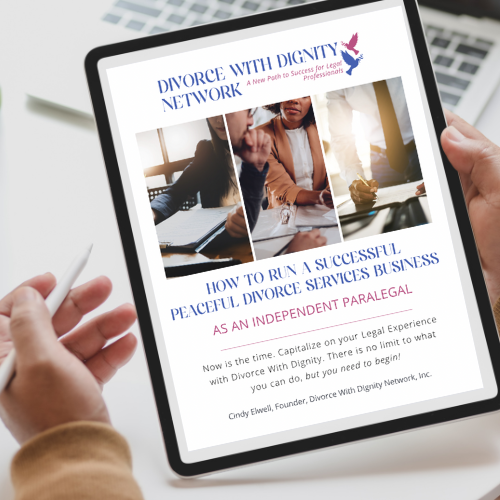For legal professionals, transitioning from a litigation-based approach to mediation often comes with a fundamental shift in perspective—one that many attorneys and divorce coaches don’t fully realize until they are deep into the process. The courtroom has strict guidelines, statutes, and case law that dictate how decisions must be made, but mediation offers flexibility that allows parties to reach agreements that courts might never impose.
If you’re considering expanding your practice into mediation or are working with clients who are contemplating alternative dispute resolution, it’s essential to understand how mediation agreements differ from litigated court orders and what that means for enforceability, compliance, and creative solutions.
Understanding Mediation vs. Litigation: The Core Differences
The Role of the Decision-Maker
In litigation, a judge acts as the decision-maker. The judge applies state laws, considers legal arguments, and issues an order based on what is deemed equitable under the law. In mediation, however, the parties themselves are the decision-makers. The mediator facilitates discussions but does not render a verdict or enforce a ruling. This fundamental shift allows for significantly more flexibility in how agreements are structured.
Mediation Focuses on Interests, Not Just Legal Rights
Litigation is often framed as an argument over legal entitlements—who has the right to what under the law. Mediation shifts this focus toward interests and practical solutions that work for both parties.
For example, in a litigated divorce, a judge applying the law may be bound by state-specific guidelines on spousal support or property division, leaving little room for customization. But in mediation, parties may decide on alternative arrangements—such as trading property interests for reduced spousal support, agreeing to a non-traditional co-parenting schedule, or structuring support payments in ways that accommodate fluctuating incomes.
Mediators can help craft agreements that take into account the real-life needs of the parties rather than simply applying standardized legal formulas.
The Flexibility of Mediation Agreements
Because parties have control over their agreements, they can create tailored solutions that wouldn’t necessarily be imposed by a court. Some examples include:
- Child Custody & Parenting Plans: While courts often default to a standard schedule (e.g., alternating weekends and holidays), mediation allows for completely customized arrangements. Parents may decide that one parent has the children during the school week to maintain consistency, while the other has extended time during summers. Some parents even opt for “nesting” arrangements where the child stays in one home while parents rotate in and out—something courts rarely impose but can work well for families transitioning post-divorce.
- Property & Asset Division: Courts typically split assets based on statutory guidelines and formulas. Mediation allows for more creative solutions, such as one spouse retaining an asset in exchange for waiving interest in another, or structuring payouts over time rather than forcing an immediate division.
- Spousal & Child Support Adjustments: Courts follow formulas for spousal and child support, but mediation allows for modifications that reflect real-world financial situations. If one spouse has variable income, parties might agree on a base amount with periodic adjustments rather than relying on rigid court-ordered payments.
Enforceability of Mediation Agreements
One of the biggest concerns for legal professionals shifting to mediation is understanding how mediated agreements hold up in court. The key lies in proper drafting and legal formalization.
Turning a Mediation Agreement into a Legally Enforceable Document
In most cases, a mediation agreement needs to be converted into a formal, legally binding document. Depending on the state, this is often referred to as a:
- Mediated Settlement Agreement (MSA)
- Memorandum of Understanding (MOU)
- Stipulated Agreement
To ensure enforceability:
- The agreement must be written clearly and specifically to prevent future disputes.
- The agreement must be signed voluntarily by both parties, without coercion or duress.
- If child support or custody is involved, the agreement may need to be reviewed for compliance with state law before being approved by a judge.
- The final agreement is often incorporated into a court order, making it fully enforceable in the legal system.
Why Courts Typically Uphold Mediated Agreements
Most courts recognize that mediation is a voluntary and collaborative process and will uphold agreements unless they are found to be:
- Unconscionable – If the agreement is drastically unfair to one party, a court may refuse to enforce it.
- Contrary to public policy – Some provisions, such as waiving child support below statutory minimums, may not be allowed.
- Ambiguous or poorly drafted – If an agreement is too vague, enforcement becomes difficult.
This means that proper documentation is critical, and legal professionals transitioning to mediation must develop strong drafting skills to ensure that agreements are clear, fair, and enforceable.
The Advantages of Mediation for Legal Professionals
For attorneys, divorce coaches, and other legal professionals, incorporating mediation into their practice provides distinct advantages:
Expanding Your Services & Client Base
Many clients seek mediation specifically to avoid the adversarial nature of litigation. Offering mediation as part of your practice can attract clients who might otherwise avoid hiring an attorney.
Increased Predictability & Efficiency
Litigation is often unpredictable in terms of time and cost, whereas mediation allows professionals to structure sessions, manage caseloads efficiently, and operate on a prepaid or flat-fee model.
Greater Client Satisfaction & Long-Term Referrals
Clients who resolve their divorce through mediation often experience less post-divorce conflict, which means fewer disputes requiring modifications and a higher likelihood of referrals from satisfied clients.
Professional Growth & Fulfillment
Many legal professionals find mediation to be a more rewarding practice than litigation. Instead of being locked in adversarial battles, mediators help clients find solutions that foster cooperation and future stability.
A Holistic Approach to Divorce Mediation
At Divorce With Dignity, we believe that mediation isn’t just about resolving disputes—it’s about creating pathways for healthier transitions. That’s why we take a holistic approach, serving as a single point of contact for resources, referrals, and support.
Our network provides: ✔ Business & marketing support to help professionals grow their mediation practice. ✔ Guidance on mediation agreements and enforceability across all 50 states. ✔ A collaborative community of like-minded professionals who believe in peaceful divorce solutions.
Are You Ready to Integrate Mediation into Your Practice?
If you’re a legal professional looking to expand your services and offer a smarter, more effective approach to divorce resolution, the Divorce With Dignity Network can help.
We provide the structure, branding, and support to help you build a successful mediation practice—while ensuring that agreements are legally sound, enforceable, and customized to meet clients’ needs.
Want to learn more? Schedule a call today to explore how you can become a part of the Divorce With Dignity Network and start offering mediation services that truly make a difference.





